Watkins Glen, New York was and is my car racing Mecca. John Ferguson introduced me to it and car racing many years ago. In the late sixties, early seventies racing’s most elite drivers gathered from around the world to compete in the prestigious Formula One races at the Glen.
Watkins Glen is a small village, whose population swelled during this time. A quarter of a million people used to converge at this scenic Upstate New York location to watch the races, drink alcohol, raise hell and have a weekend-long party held always during the first weekend in October.
Racing at Watkins Glen dates back to the 30s, when cars were racing through the local roads and streets of the village. A deadly accident killing some spectators altered the race course forever. The facility now sits atop a mountain overlooking the scenic Seneca Lake. When I first started going to the races the track length was much longer than it is now (over 5 miles, memory serves), so the activities could not be observed from one place. Driving to the track meant climbing a pretty good incline. Looking back a gorgeous view of the lake was afforded, then the track came into view. Almost simultaneously you were treated to the smell of burning castor oil used for racing. I will never forget this smell. It signified that you have arrived! Although racing was always over four days (Thursday through Sunday) we could never get the time to get there until late Friday or Saturday morning, by which time the race cars were already circling the track, qualifying or practicing.
Part of the reason for going was to watch the many exotic cars belonging to the spectators. Ferraris and Lamborghinis could always be observed either driving around the village or parked behind restrictive fences of private club’s parking lots. Back then you could get really close to the race cars also.
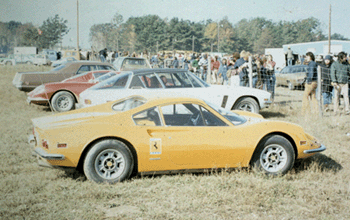
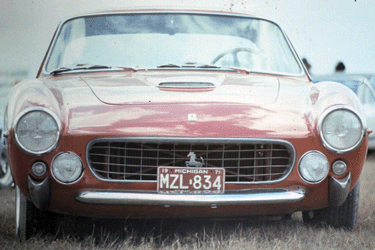
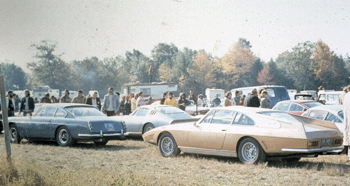
The garages were infield and there was a road leading from the garages to the track. Most of the time the race cars were driven by mechanics but once in a while you could catch a glimpse of someone famous in the cockpit. I saw Dan Gurney, Stirling Moss and Jack Brabham this way. They were literally inches from me. There were goose bumps galore! Once I was standing on this road when a 427 Cobra idled by me, literally shaking the ground. The guy was looking very nonchalantly, and I was sooooo envious!
During the evening you could go inside the garages and watch the mechanics work on these works of art. Once in a while one would be started up and the throttle blipped lightly, then harder, sending shivers up my back.
We attended a Can Am race one year. For those who don’t know, these monsters sported huge wings and had big-block V8 engines of unlimited size and horsepower and they literally shook the ground and the inside of your chest whenever they sped by. It was always an awesome experience. I was prepared with two cameras but I brought no film for either, saying that I will get film at the track. When we got there nobody had film and I had no time to go down to the village to find some. Shortly after the start there was a bad accident just past our vision to the left. All we could see was the smoke. The race was red-flagged and all the drivers parked their cars and got out and talked with some of the spectators and her I was with TWO cameras and no film. This taught me an important lesson and I never left without film again.
These races attracted all kinds of people, some nice, some not. I local told me about a couple he saw walking on the streets of Watkins Glen, who could’ve been members of a bad motorcycle gang. He was wearing a glass vial around his neck with his girlfriend’s finger in it, which she cut off, to presumably prove her love for him.
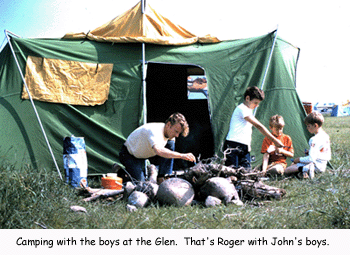
To save money we always camped at the races. In the beginning we didn’t have camping equipment, so we tried to sleep in the car. I say “tried” because the partying went on until the wee hours of the morning. I never enjoyed these nights.

One year there was a bunch of guys driving around the infield in the back of a pickup truck. There was a large hand-drawn sign “SHOW US YOUR TITS” dangling from a frame in the bed. Much shouting and drinking could be observed while they were looking for their “victim”, a well-endowed young woman. Once they found one, they made their request and quite often were obliged, amid more rowdiness and drinking.
At the farther reaches of the track there was a muddy spot. Some inebriated spectators took delight in riding through this spot with their motorcycles. To not get their clothes dirty (what???), they stripped down to their underwear (remember, it was October) and had a great time, much to the delight of those other inebriated bystanders. More and more people joined in as the years went by, as the muddy hole kept growing in size. Someone nicknamed it “The Bog” and the next year there were t-shirts with the picture of The Bog with an arm reaching out from the mud, with the words underneath “The Bog Wants You”.
Soon riding a motorcycle through wasn’t enough, so they started with cars. When one got stuck, they lit a match to it and let it burn. The last year of the bog’s life a Greyhound bus was driven into the mud hole with people’s luggage still on it and, when it got stuck, they burned it, too. I guess the authorities drew a line and The Bog died. It wasn’t too long after that the Formula One races were stopped and they have not returned since. Corning bought the track and poured a lot of money into it, raised the ticket prices and the whole ambience changed. It was fun while it lasted, unless you came in on a Greyhound bus.

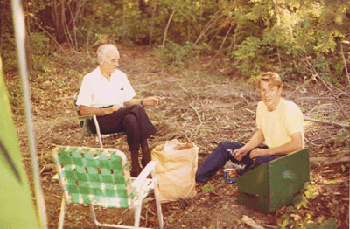
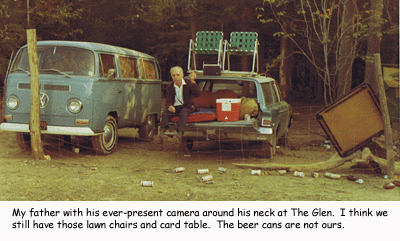
I took my father with us to the races once. He loved to take pictures and I was pretty sure he hadn’t seen anything like this before. John Ferguson was with us, and we all slept in his tent. When we got up the next morning, I sensed that my father wasn’t happy about something, so I asked him. He said it was that he couldn’t shave. For decades previous to that day, he shaved every day but that day he couldn’t. He also wore a tie every day, unless it was extremely humid or when he was watching a car race.
We walked up to the fence to get as close to the cars as possible. We pointed our cameras and waited for the cars to come by. They were very close to us at this part of the track, and they were going very fast. The technique to photograph a fast-moving object is called panning. Framing the car in the viewfinder you move with the car as you squeeze the button. The effect of doing this keeps the car in focus, while blurring the background, giving the sensation of movement. He just wasn’t fast enough at this part of his life. He kept trying to do it, but he kept missing it, growing frustrated. Now that I am his age, I fully understand his dilemma and wish I could tell him. Another time we were watching the race when a wall of fog rolled onto the track. It was so thick that I couldn’t see the track and the race was red-flagged. Never before, nor since have I seen this phenomenon.

John Ferguson bought a Formula V opened-wheel race car powered by a Volkswagen engine. He asked me to “pit” for him at his debut in Watkins Glen. We had much trouble with the car, and I certainly didn’t have much fun trying to push-start it.
Years later after building the Pinto I got a chance to observe my Porsche mechanic racing at Watkins Glen. He had a Formula B race car which really wasn’t running all that great, but I got to sit in it and here is the picture to prove it. It felt great, by the way!